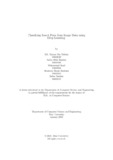| dc.contributor.advisor | Ashraf, Faisal Bin | |
| dc.contributor.advisor | Reza, Md. Tanzim | |
| dc.contributor.author | Mohsin, Md. Raiyan Bin | |
| dc.contributor.author | Ramisa, Sadia Afrin | |
| dc.contributor.author | Saad, Mohammad | |
| dc.contributor.author | Rabbani, Shahreen Husne | |
| dc.contributor.author | Tamkin, Salwa | |
| dc.date.accessioned | 2022-06-06T07:09:40Z | |
| dc.date.available | 2022-06-06T07:09:40Z | |
| dc.date.copyright | 2022 | |
| dc.date.issued | 2022-01 | |
| dc.identifier.other | ID 18101639 | |
| dc.identifier.other | ID 18101469 | |
| dc.identifier.other | ID 14101135 | |
| dc.identifier.other | ID 18101134 | |
| dc.identifier.other | ID 18101511 | |
| dc.identifier.uri | http://hdl.handle.net/10361/16914 | |
| dc.description | This thesis is submitted in partial fulfillment of the requirements for the degree of Bachelor of Science in Computer Science and Engineering, 2022. | en_US |
| dc.description | Cataloged from PDF version of thesis. | |
| dc.description | Includes bibliographical references (pages 48-50). | |
| dc.description.abstract | The fact that insecticidal pests impair significant agricultural productivity has become
one of the main challenges in agriculture. There are, nevertheless, several
requirements for a high-performing automated system that can detect pest insects
from vast amounts of visual data. We employed deep learning approaches to correctly
identify insect species from large volumes of data in this study model and
explainable AI to decide which part of the photos is used to categorize the insects
from the data. We chose to deal with the large-scale IP102 dataset since we worked
with a large dataset. There are almost 75,000 pictures in this collection, divided
into 102 categories. We ran state-of-the-art tests on the unique IP102 data set to
evaluate our proposed solution. We used five different Deep Neural Networks (DNN)
models for image classification: VGG19, ResNet50, EfficientNetB5, DenseNet121,
InceptionV3, and implemented the LIME-based XAI (Explainable Artificial Intelligence)
framework. DenseNet121 performed best across all classes, and it was also
employed to detect crop-specific insect species. The classification accuracy for eight
specific crops ranged from 46.31% to 95.36%. Moreover, we have compared our prediction
performance to that of earlier articles to assess the efficacy of our research. | en_US |
| dc.description.statementofresponsibility | Md. Raiyan Bin Mohsin | |
| dc.description.statementofresponsibility | Sadia Afrin Ramisa | |
| dc.description.statementofresponsibility | Mohammad Saad | |
| dc.description.statementofresponsibility | Shahreen Husne Rabbani | |
| dc.description.statementofresponsibility | Salwa Tamkin | |
| dc.format.extent | 50 pages | |
| dc.language.iso | en | en_US |
| dc.publisher | Brac University | en_US |
| dc.rights | Brac University theses are protected by copyright. They may be viewed from this source for any purpose, but reproduction or distribution in any format is prohibited without written permission. | |
| dc.subject | IP102 | en_US |
| dc.subject | Insect pest | en_US |
| dc.subject | Transfer learning | en_US |
| dc.subject | Data augmentation | en_US |
| dc.subject | Classification | en_US |
| dc.subject.lcsh | Cognitive learning theory (Deep learning) | |
| dc.subject.lcsh | Machine learning. | |
| dc.subject.lcsh | Artificial intelligence | |
| dc.title | Classifying insect pests from image data using deep learning | en_US |
| dc.type | Thesis | en_US |
| dc.contributor.department | Department of Computer Science and Engineering, Brac University | |
| dc.description.degree | B. Computer Science | |

